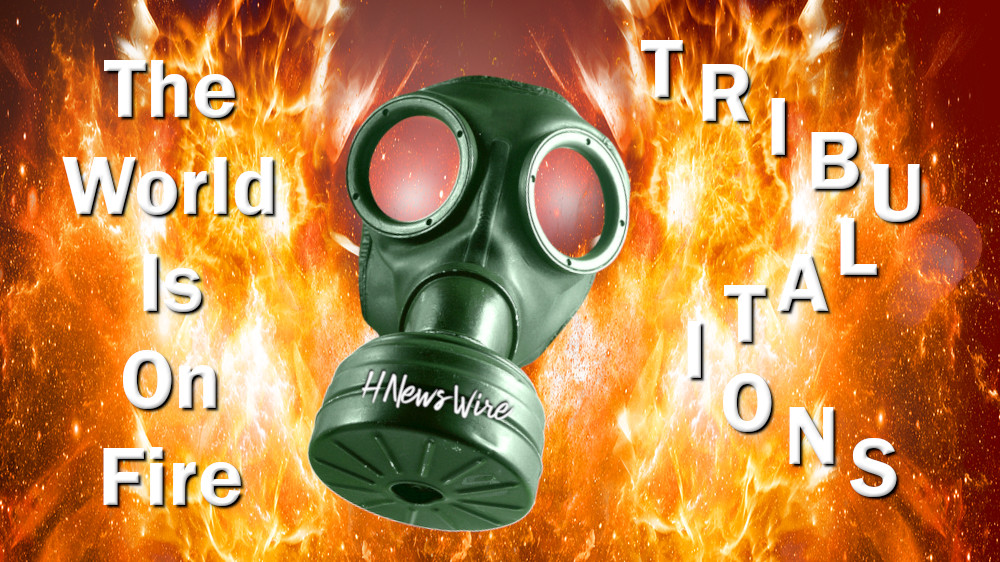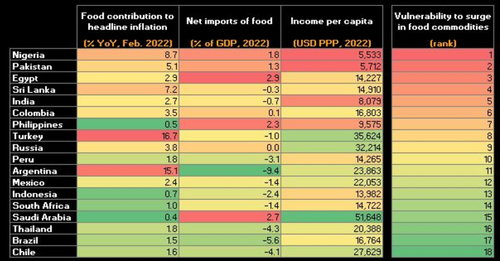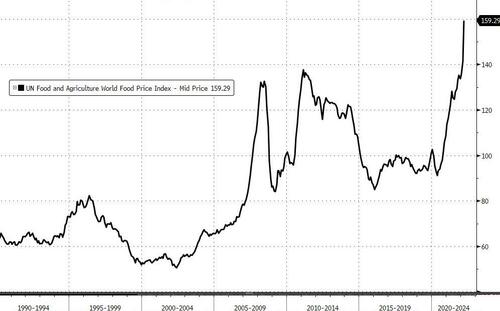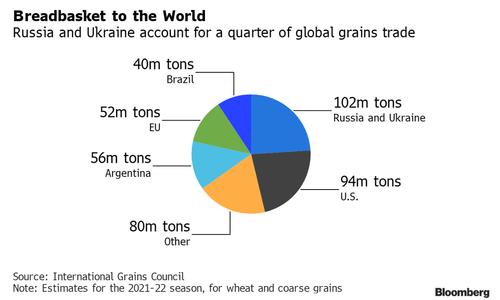Update: 4/8/22 Satan Soldiers at U.N. Warns Middle East at “Breaking Point” as Plandemic in Full Swing and Food Prices Hit Alarming Highs ,Tribulation!
![]()
It's going to become very bad. As the situation in Shanghai deteriorates, citizens have started defying the CCP's authority in ways that are unusual in China. Since the outbreak of the pandemic, the CCP's decision to take a "war-like" approach in order to implement its "zero COVID" policy has seldom met with significant opposition. That is, until today.
Videos of Shanghai residents singing on their balconies in protest of the municipal authorities' decision to enforce a "indefinite" lockdown went viral in the West yesterday (they were quickly censored on Weibo).
On Wednesday, authorities identified over 20,000 cases in Shanghai alone, nearly equal the total number for China the day before. According to the SCMP, it was the city's sixth daily record. The number of symptomatic cases increased to 322, up from 311 the day before, with the great majority of individuals showing no symptoms. Local authorities have registered around 70K instances since March 1.
We observed a few days ago that the situation in Shanghai had progressed beyond a public health catastrophe. Instead, it has become a political litmus test for the CCP as it battles to maintain the legitimacy of its "zero COVID" policy. In this sense, the fight for Shanghai has become "too huge to fail."
The New York Times confirmed this on Thursday.
As the coronavirus spreads across Shanghai in the city's largest epidemic since the pandemic started, officials have used their customary hard-nosed approach to attempt to stop transmission at any cost. What has been unusual is the public reaction, which has been unprecedented in China since the chaotic early days of the epidemic in Wuhan.
The Shanghai situation is turning out to be more than simply a public health issue. It is also a political litmus test for the Communist Party's zero tolerance policy, on which it has based its legitimacy.
For the most part of the last two years, the Chinese government has muzzled most domestic criticism of its zero-tolerance COVID approach via a combination of censorship, arrests, and effectiveness in keeping caseloads low. However, in Shanghai, where more than 70,000 cases have been reported since March 1, this is proving more challenging.
Shanghai is China's most populated city and its gleaming commercial core. It is home to a thriving middle class as well as numerous members of China's corporate, cultural, and intellectual elite. Shanghai has a significant proportion of foreign-educated Chinese inhabitants, and its residents have the greatest per capita discretionary income in the nation. Even in a society where dissent is punishable by death, many people have long found methods to demand government accountability and have a voice in their own lives.
"I'm simply too furious, too sad," said Kristine Wu, a 28-year-old IT firm employee who was visited by two police officers at her home after criticizing the city's Communist Party chairman on social media. She filmed her confrontational encounter with them, in which she questioned why they were bothering her when they might be assisting those in need. Despite the cops' cautions, she subsequently posted a picture of the interaction on social media. (It was afterwards censored.)
"I simply thought, whatever, I'll just go for it," Ms. Wu, who had not considered herself politically before to the lockdown, said. I used to live really well, and before anything bad occurred, everyone was extremely nice and followed the rules. All of it has now shattered. "
The CCP is in a terrible situation. Public health professionals are acutely aware that China is unprepared to deal with the coronavirus: as of late March, just slightly more than half of Chinese aged 80 and above were properly vaccinated. Furthermore, Chinese vaccinations have been demonstrated to be less efficient than western equivalents.
According to the Associated Press, the people of Shanghai are already suffering from debilitating food shortages as they are forced to depend on the government for crucial supplies.
Shanghai residents are unable to get meat, rice, and other food supplies due to anti-coronavirus measures that have confined the majority of the city's 25 million residents to their homes, creating dissatisfaction as the government attempts to manage a developing epidemic.
People in China's financial center grumble that internet grocery stores are often sold out. For a few days, some people got government food packages with meat and vegetables. But, with no indication on when they would be permitted to go, tensions are mounting.
Zhang Yu, 33, said her family of eight eats three meals a day but has reduced their lunch to noodles. They did not get any government supplies.
"It's not simple to keep this up," Zhang, who begins buying online at 7 a.m., said.
"We read in the news that there is (food), but we can't afford it," she said. "As soon as you open the grocery shopping app, it tells you that today's orders have been completed."
According to Bloomberg, as the food scarcity intensifies, containers full of frozen food and chemicals are building up at Shanghai's largest port as the city's lockdown and virus testing prohibit employees from traveling to the docks to pick up boxes.
Of course, Shanghai isn't the only city in China dealing with a pandemic. Even though officials nominally ended a weeks-long lockdown, the province of Jilin is still suffering a surge (and the related limitations).

HNewsWire-Nigeria, India, Colombia, Philippines, and Turkey all bear watching, along with Russia...
Global food prices jumped to a new record high, soaring the fastest on record, as the conflict in Ukraine unleashed food supply shocks across the world.
“The current conflict between Ukraine and the Russian Federation is increasing the risk of a further deterioration of the food insecurity situation at global level,” the FAO said in a recent food insecurity assessment (pdf).
March's food price index from the Food and Agriculture Organization of the United Nations (FAO) printed 159.3 points in March, up 19.15 points from February, when it had already reached record highs. The index was up 33.6% from the same time last year.
The March rise in food prices is a stunning 12.64% MoM - almost double the previous record monthly surge...
Leading the charge was the FAO Cereal Price Index, up 17.1% in March than in February, entirely driven by significant price increases in wheat and grains as a result of the Black Sea breadbasket region going offline because of the Russian invasion of Ukraine and sanctions-related supply disruptions by Western countries on Russia. The invasion has choked off more than a quarter of the global wheat trade, about a fifth of corn, and 12% of all calories traded globally.
Another driver was FAO Vegetable Oil Price Index, up 23.2%, driven by higher prices of sunflower seed oil, of which Ukraine is the world's leading exporter. Palm, soy, and rapeseed oil prices increased due to higher sunflower seed oil and Brent crude prices.
It's not just a shortage of food, but also shortages of fertilizer and skyrocketing diesel prices, the ability to farm and even perhaps produce robust harvests by the end of the Northern Hemisphere growing season could be in jeopardy, which would ultimately extend the global food crisis through 2023.
"Looking forward to 2022-23, we're already seeing signs that production is going to be reduced in Ukraine," Erin Collier, an economist at the UN, told Bloomberg.
"The amount they're able to export really depends on how much longer this conflict continues."
The bad news is the world's hunger problem isn't going away and may only get worse from here...
The risks of soaring basic foods are possible inflation riots in emerging market economies. Last week, the UN pointed out millions of Middle Eastern and North African families struggle to buy even the most basic foods to keep hunger at bay.
"People's resilience is at a breaking point. This crisis is creating shock waves in the food markets that touch every home in this region. No one is spared," Corinne Fleischer, UN's World Food Programme Regional Director said.
The risk of uprisings is increasing by the week as the UN projects food prices to soar even higher. It's important to note that food prices were already rising before the Ukrainian conflict.
We've outlined the most reliant countries on Ukraine wheat, including Egypt, Indonesia, Bangladesh, Pakistan, and Turkey (the countries that could see unrest first).
However, in South America, inflation riots have already begun as the government declared a curfew last weekend. Arab Spring 2.0 appears to be emerging, but this time it could be global, unlike a decade ago.

![]()
HNewsWire-Food riots in the Middle East might be on the horizon at any moment.Emerging market families were particularly severely hit by food inflation prior to Russia's invasion of Ukraine, which interrupted the global food supply.
WFP warned Thursday that a toxic mix of violence in Ukraine, COVID-19 economic disruptions, and disastrous harvests are pushing food prices at record levels, as worries of food shortages grow, according to a new WFP study.
Millions of households in the Middle East and North Africa are unable to afford even the most basic necessities to avoid famine, according to the World Food Program (WFP).
"There is a limit to human endurance. The food markets in this region have been rocked by this crisis, which is affecting everyone in the area. There is no one who is safe "Corinne Fleischer, WFP's Regional Director, said this. '
At 351 percent a year, Lebanon's annual cost of basic food is the highest in the region; Syria's annual cost of food is close to 100%; and Yemen's annual cost of food is just over 81%. This trio of nations is highly dependent on food imports, which makes them vulnerable to currency devaluation. Syria's yearly wheat output has been curtailed by a catastrophic drought, while grain shipments from Ukraine have been halted.
Our favorite permabear, Albert Edwards of SocGen, predicted two years ago that a future agriculture price shock might trigger another Arab Spring.
Approximately a quarter of the world's wheat is sent out of Russia and Ukraine, as is roughly a fifth of the maize, and about 12% of the calories exchanged throughout the world come from these two countries. Middle Eastern and North African nations are seeing rising costs and food shortages as a result of trade disruptions in both regions.
According to Bloomberg, Egypt, Indonesia, Bangladesh, Pakistan, and Turkey are the nations most dependent on Ukrainian wheat. These are also the nations where societal instability is most likely to occur.
If the Food and Agriculture Organization of the United Nations is true, food costs might rise an additional 20%, putting even more pressure on families in developing countries.
The World Food Program (WFP) has issued a dire warning that millions of families in the nations listed above are on the verge of "breaking point" due to rising food prices.
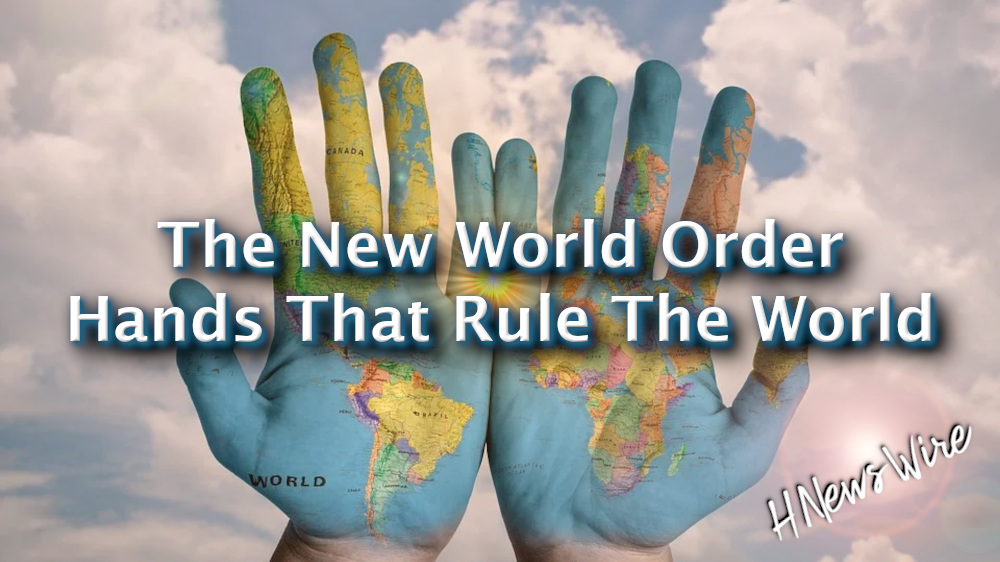
I remind you that we are dealing now with what the Old Testament prophets called “the great and terrible day of the Lord.” I find it difficult to make such messages amusing or entertaining. It strikes me that to attempt it would be somewhat analogous to hiring a comedian to entertain the witnesses at a public execution! This is not entertaining material, I grant you, but it is true! And we have to face unpleasant truth at times. SRH…

